Sandia Crest, just east of Albuquerque, is the only easily accessible site at which they all may be seen together. In September, the Crest House Restaurant and Gift Shop reopened under new ownership and management, with plans to stay open all winter.
After visiting our son and his family in Canyon, Texas, we drove to Albuquerque on Monday (November 4), and spent two nights there. Before getting into town we stopped at Sandia Crest to meet the new Manager, Nick Harada. As we started up the 14 miles to the Crest, we noted that the temperature was 55 degrees (F) at the base of Crest Road (about 7,000 ft elevation). The skies were clear and there was little wind, a perfect day.
Our first stop along the road was at Doc Long Picnic Area, where we heard the warbled song and brief whistled calls of a Townsend's Solitaire. This drab member of the thrush family breeds on high mountains throughout western North America. Northernmost populations from Alaska and Canada migrate south into the US and to lower elevations, supplementing the numbers of local birds during the winter.
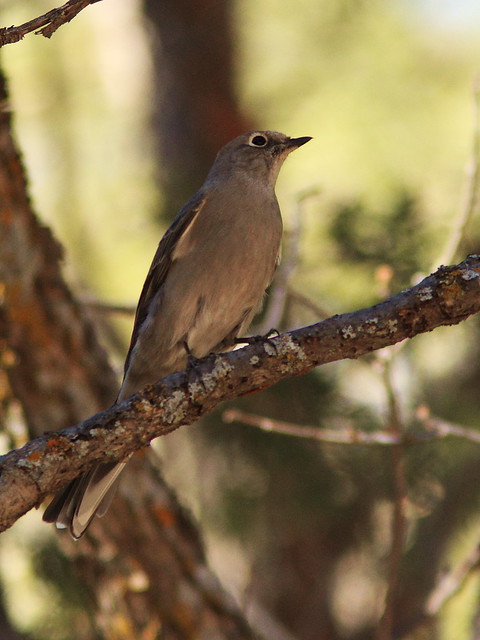
On our way up we stopped at several pull-outs hoping to hear or see some birds such as crossbills or other winter finches. This is the view from 10K Trailhead, with smoke from a forest fire evident on the horizon to the north.
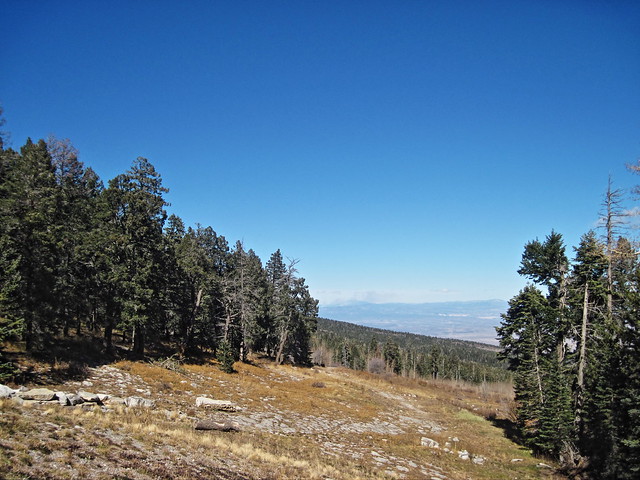
Up at the top, at an altitude of over 10,600 feet, the temperature was 32 degrees! There had only been a dusting of snow the previous week, and no snow cover, so it was not surprising to find that the rosy-finches had not yet arrived. Typically, they fly in with the first real snow storm, which was expected to hit that night and continue into the next day. This is the entry to Sandia Crest House Gift Shop and Restaurant.

We were hungry after the 4 1/2 hour drive from Amarillo, so we had lunch at one of the tables next to the glass wall that overlooks the deck where the rosy-finches will soon visit the hanging feeder. We talked to the other workers and enjoyed Green Chile Cheeseburgers. The famous bowl of green chile is still on the menu. I feel confident that the staff will continue to be very birder-friendly, and I hope that visitors reciprocate by purchasing food and drinks as well as merchandise.
I created this 180 degree panoramic view of the interior of Crest House with my new iPhone. The kitchen is to the left and the west-facing deck is at the right. The two windows in the center background are on the east wall of the Gift Shop section of Crest House and they overlook a second feeder. It is easy to understand the popularity of this location, where birders can sit in comfort and tick off three new bird species that brave the harsh mountaintop winters.

The deck provides a marvelous view of the City of Albuquerque a mile below.
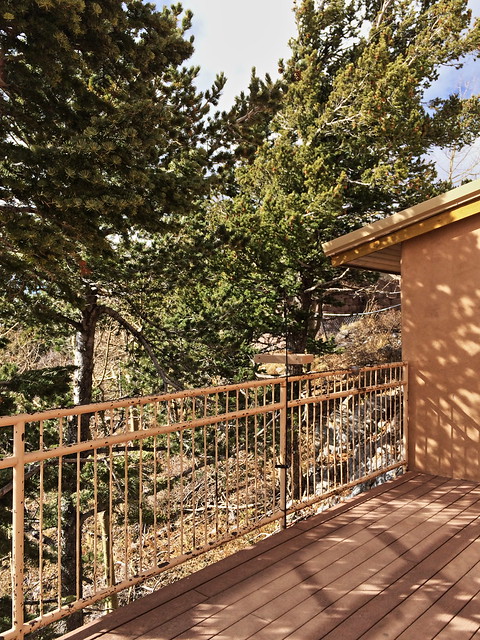
This is the southwest-facing view from the deck. Sandia Mountain courses away to the south (far left), and the Manzano Mountains are in the distance, behind the Manzanita foothills. These mountains are considered to be the southern extreme of the Rocky Mountain chain, all consisting of sedimentary rock uplifted by collision of tectonic plates. To the far right is Mount Taylor (elevation 11,301 feet), the cone of an extinct volcano, 80 miles to the west, but visible on this clear day.
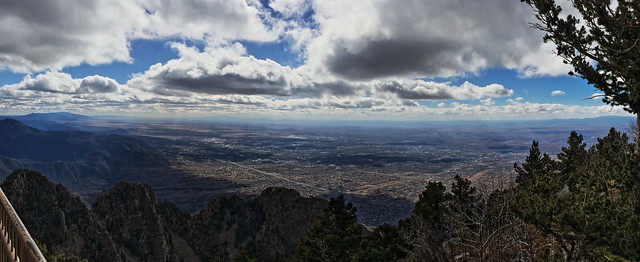
The feeders had been put up a few days previously and were hosting Steller's Jays, both Red-breasted and White-breasted Nuthatches, juncos, a Downy Woodpecker, and Mountain Chickadees.
Steller's Jay on the deck feeder:
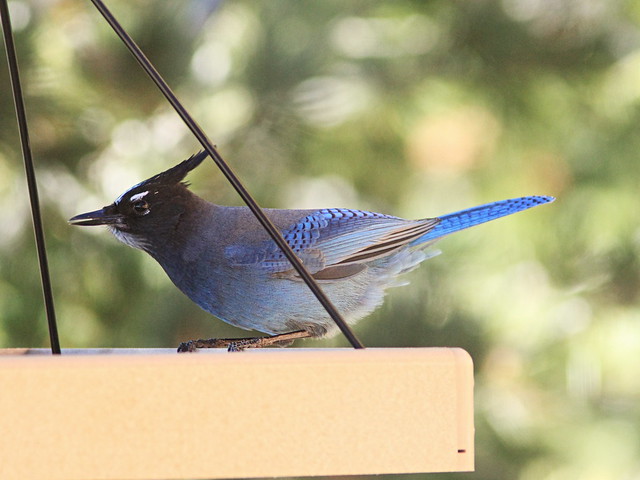
Red-breasted Nuthatches flew in and quickly removed one seed at a time, retiring to the trees to either eat or hide them:

My photos were taken through the glass, so they are not of very good quality. This White-breasted Nuthatch seems to defy gravity as it strolls up the trunk of a tree.
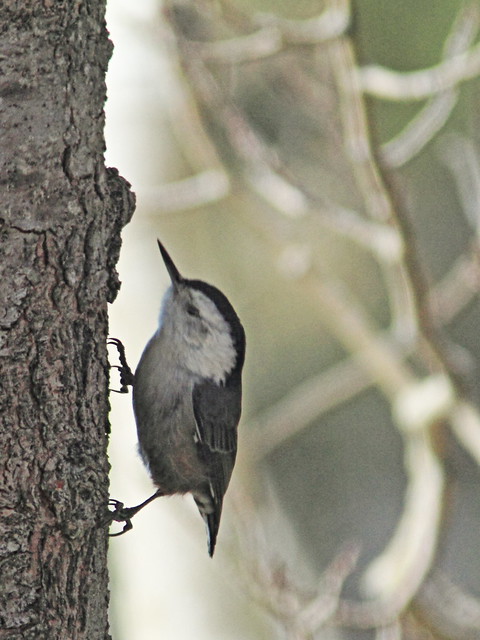
The second feeder is positioned downhill, just to the southeast of the Crest House.
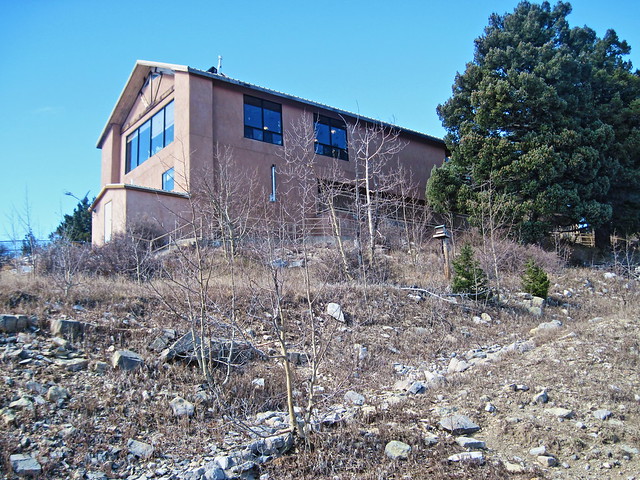
It is readily visible from the picture windows.
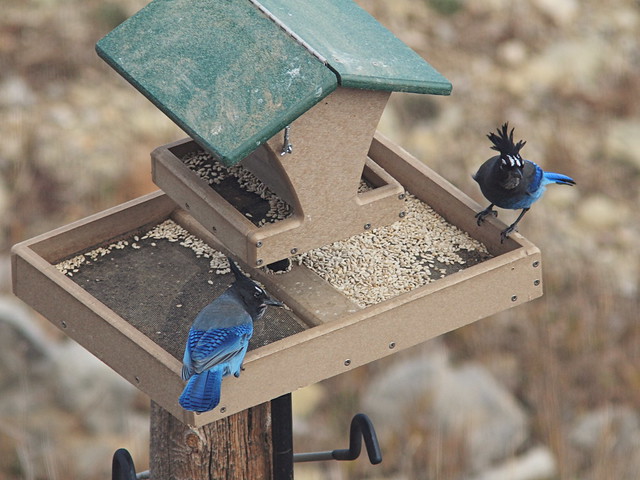
Although Nick had just started his job as Manager and had never before heard about the rosy-finches he was very interested in learning all he could about them and the other feeder birds. We reviewed pictures of the three rosy-finch species and the Hepburn's variant.
That evening we had a very pleasant meeting and dinner with the Crest House owner, Andy Mayer. He has given a lot of thought as to how to make birders feel at home, and is supportive of the scientific and educational value of the banding program. Banding is scheduled as usual on most Sunday mornings during the winter. Nick also plans to put up hummingbird feeders on the deck after the rosy-finches depart, which also should attract much interest from the general public.
The weather indeed took a nasty turn the next day. When we set out at about 8:00 AM there was light rain and the temperature was 45 degrees in Albuquerque (5200 feet elevation). The Sandia Mountains were shrouded in clouds and the weather reports predicted that the snow that started there during the night would continue until around noon. We therefore decided to first visit Rio Grande Nature Center State Park in Albuquerque (more about that in a subsequent post).
At about 11:00 AM we decided to venture up to Crest House for lunch. The sky was blue and the road was clear until we got near the ski area, at about 9,000 feet elevation. Clouds and blowing snow caused episodes of near white-out conditions. The road was snow-packed above Nine Mile Picnic Area, but we continued up in our rental Toyota Camry. At Crest House, the temperature was down to 24 degrees (F) with high winds.
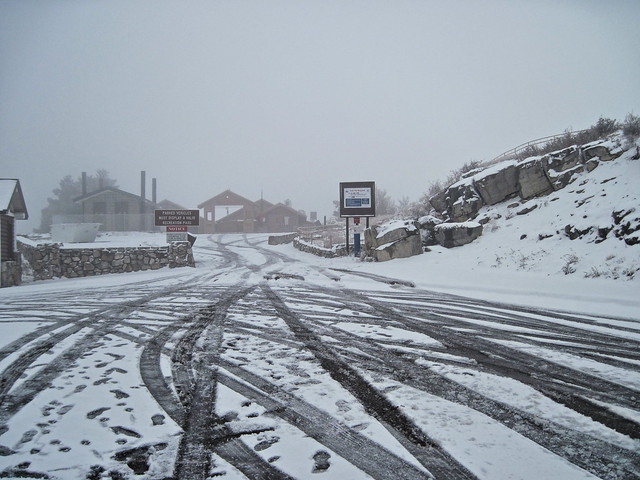
We could barely see the lower feeder from the picture window, and the hanging tray feeder on the deck was swinging wildly. The only birds we saw were Steller's Jays, White- and Red-breasted Nuthatches, Mountain Chickadees, ravens and a few juncos. With those wonderful snow conditions we knew that the rosy-finches would be there on the heels of the storm. We were right!
The next morning, at about the same time we were boarding the plane to return to Florida, John and Thelma Dalmas of Nacogdoches, Tx saw 4 Black and 2 Gray-crowned Rosy-Finches at the feeder. Later in the day, Alan Mickelson, feeder program coordinator, went up to fill the feeders and saw a single Gray-crowned Rosy-Finch. In the weeks since then, all three species have been seen at the feeders.
I must dig into my archives to find one of my photos, this of a Black Rosy-Finch at the deck feeder:
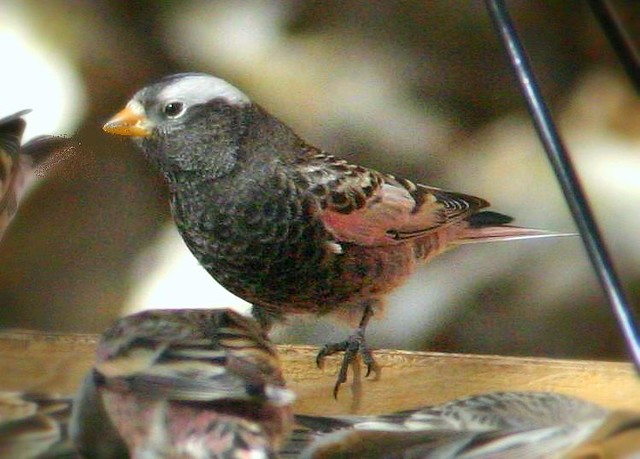
From the window of our aircraft as we climbed over the Manzanos, we got our last view of Sandia Crest, poking up conspicuously in the distance. It is nice that we at least have a pixelated photo of this season's rosy-finches. At this range, hundreds would fit into a single pixel!
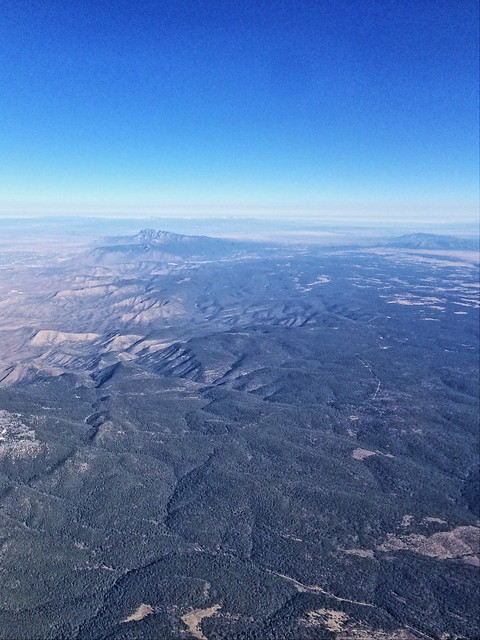
As soon as we arrived home I edited the Sandia Crest Birding FORUM and replaced this flag...
...with this one, announcing arrival of the finches!
Useful Links:
Directions to Sandia Crest House with notes about Health and Safety, Handicapped Access and birding in and around the Sandia Mountains
Sandia Crest House Restaurand and Gift Shop Web page (with menu)




such an interesting post, your travels and a delightful place to stay over for two days enjoying the birds at the feeders.
ReplyDeleteThank you for sharing this info! We are planning on heading up there in February and really hope to see all three of these birds. In fact, it's our first exciting trip planned for the year! Cannot wait and crossing my fingers that we get to see all three. I'm going to share this with the crew:)
ReplyDeleteGreat post and nice variety of birds! Thanks for sharing, happy birding!
ReplyDeleteThis is definitely a place I want to visit, and soon! Thanks for the wonderful report and photos!
ReplyDeleteLove your birds! The black rosy finch, the stellar jay, the red-breasted nuthatch - all foreign to this area as far as I know.
ReplyDelete